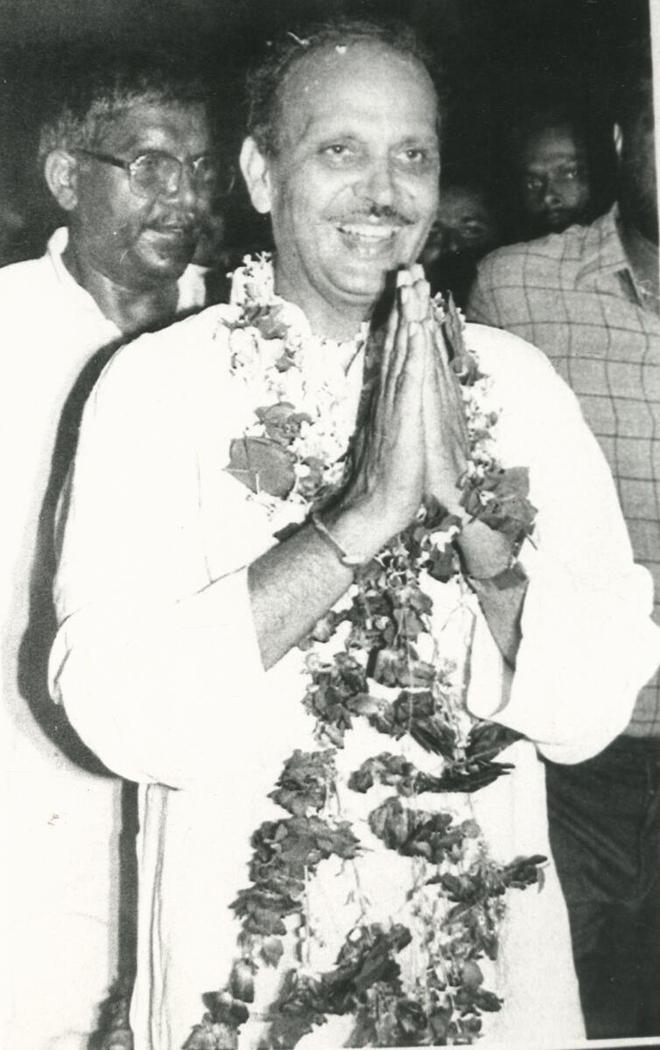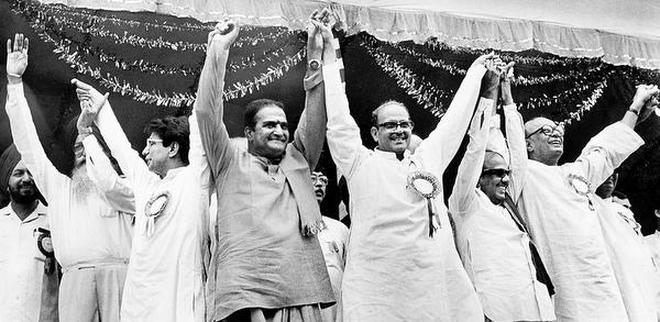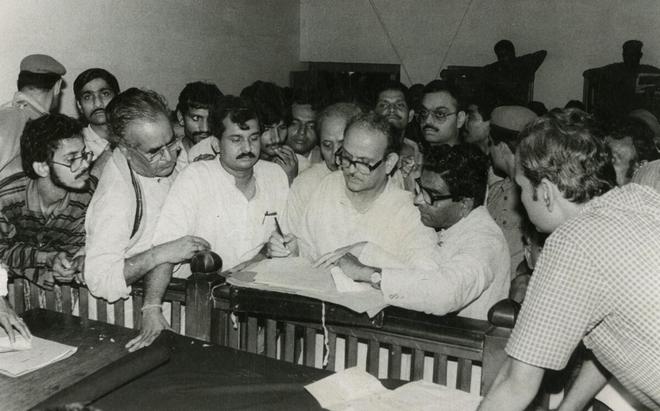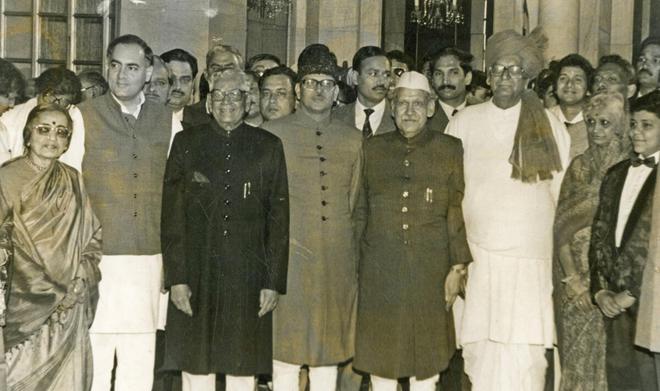After four decades of total electoral dominance in Independent India, the reign of Indian National Congress (INC) came to an end with a humiliating defeat in the late 1980s. Despite emerging as the single-largest party in the November 1989 election, which saw no party getting a clear mandate, the Congress, under the leadership of PM Rajiv Gandhi, was the biggest loser as it bagged less than half of the total seats it won in its 1984 landslide victory.
The party lost not only national power but also political dominance, as opposition parties from across the political spectrum joined hands in the throes of the Bofors scandal, ushering in a new era of coalition politics and the ‘third electoral’ system in the country. However, this coalition government, the first since the Janata experiment of 1977, did not last long and fell prey to ‘Mandir and Mandal’, a series of socio-religious events that prompted a political realignment which eventually changed the country’s political landscape forever.
Lows after the highs of 1984

A young and politically inexperienced Rajiv Gandhi took over as the Prime Minister of India after his mother Indira Gandhi’s assassination, leading the Congress party to a stunning victory in the 1984 general elections, where they won 404 of the 514 Lok Sabha seats.
At the time, Mr. Gandhi was extremely popular with the electorate. It was, however, his Finance Minister Vishwanath Pratap Singh, or V.P. Singh who emerged as his alternate in national politics. During his tenure as the Union Finance Minister, V.P. Singh initiated sweeping economic reforms, allowing foreign investment into India and launching a series of high-profile tax raids against powerful businessmen and industrialists such as the Ambanis.Opinion polls rated the “Raja of Manda” as one of the top politicians in the country at the time.
Also read | The Janata Parivar in electoral politics: a timeline
But after a few years in power, differences emerged between the two leaders. Amid escalating tensions, Rajiv moved V.P Singh to the Ministry of Defence in January 1987 — a step some believed was an effort to placate the angry business community, the primary contributor to the Congress Party coffers. Mr. Singh accepted his “neta ka hukum”, but refused to bow down since he saw the move as a demotion.
A few months into the new assignment, V.P. Singh announced that the MoD was investigating allegations of commissions being taken in a defence deal for the purchase of submarines.
He came under heavy attack. His Cabinet and party colleagues slammed him for failing to take the Cabinet into confidence before ordering a probe. Mr. Singh was pushed into a corner. “I suppose it was at that time I realised there was no hope any more, that I had neither honour nor future there. After all, I had been to jail in 1977, 1978, and 1979 for Mrs. Gandhi and they were questioning my loyalty to her. I mean things became so petty that I was reduced to the embarrassing position of obtaining my jail certificates to prove my loyalty to the party,” he later told the magazine India Today in an interview. .
In April 1987, V.P. Singh dropped a sealed white cover, merely marked ‘Prime Minister,’ at Mr. Gandhi’s official residence. Headlines across the world soon announced that the Indian Defence Minister had resigned under intense pressure. “I have quit from office to nail the lie that I was over-ambitious and sticking to the chair. I hereby publicly declare that I will not hold any government office in my life,” Mr. Singh said.
Later that year, he was expelled from the party along with Rajiv Gandhi’s cousin Arun Nehru.
The crises
Shortly after V.P. Singh’s resignation, Swedish and Indian media broke the Bofors scandal. Investigative reports disclosed that, in the 1980s, Swedish arms manufacturer Bofors had paid kickbacks to top Indian politicians and key defence officials to secure a Rs 1,437-crore deal for the sale of artillery guns. There were allegations that bribes were paid out to senior politicians and key defence officials in secret Swiss Bank accounts. Rajiv Gandhi was also implicated in the case.
Later, it was revealed that a private firm— hired by then Finance Minister V.P. Singh to probe suspected violations of currency control laws by some wealthy Indians— found leads indicating that Bofors had paid bribes for a defence deal with India. Investigator Michael Hershman of the Fairfax Group claimed in an interview that he had alerted the Finance Minister, who then retained the services of his firm, asking them to continue the probe.
Mr. Singh was once again criticised by the ruling party for “embarrassing” the PM and giving ammunition to the Opposition. Congress leaders questioned how government information was passed on to foreign powers.
The Prime Minister, meanwhile, denied any wrongdoing. He informed the nation via an address to Parliament that no kickbacks were paid. But his assurances weren’t enough to prevent he political earthquake that followed.
An isolated V.P. Singh, meanwhile, charted a path for himself that eventually opened a new chapter in India’s political history.
Mr. Clean vs. Mr. Cleaner
Amid political melodrama, the Centre reiterated its commitment to act against economic offenders, but a storm of charges forever reduced the term to a pejorative. Instead, V.P. Singh was dubbed as ‘Mr. Cleaner,’ in contrast to Mr. Gandhi’s ‘Mr. Clean.’
With public support seemingly on his side, V.P. Singh formed the Jan Morcha to lead a campaign against the Rajiv Gandhi-led government along with a small group of erstwhile Congress leaders and disillusioned Rajiv Gandhi loyalists such as Arun Nehru and Arif Mohammed Khan.
A few months after his ouster, the Jan Morcha leader won a bypoll for the prestigious Allahabad seat, dealing a major blow to the ruling party, which had pitted Lal Bahadur’s son Sunil Shastri against him. The Congress also lost the Tanda (Faizabad) and Chhaprauli (Meerut) byelections. The party suffered another humiliating defeat in the Haryana Assembly elections. The Lok Dal (Bahuguna group), headed by Devi Lal, won 58 seats, the BJP got 15, while the Congress bagged five.
The results signalled a wave of change taking over the nation. An internal document of the BJP called it a “turning point”. V.P. Singh grabbed the opportunity and sought support from groups and politicians opposed to the Congress. After initial hiccups, the Janata Dal was launched in October 1988 with a promise of a centrist, secular alternative to Congress. V.P. Singh became the face of the Opposition’s anti-corruption campaign.
The new outfit, which included Janta Morcha, Ajit Singh-led Lok Dal and the Janata Party, announced at a press conference in New Delhi that elimination of corruption and decentralisation of power was on top of its agenda.
The Janata Dal later joined the National Front, formed in September 1988 with a common aim to oust the Congress from power. Besides Janata Dal, the group included Congress (S), TDP, DMK and Assam Gana Parishad. TDP’s N.T. Rama Rao was made the Chairman.

The Front canvassed support from Left and Right quarters with Rama Rao holding discussions with Jyoti Basu while V.P. Singh approached the BJP.
On October 17, 1989, the Election Commission of India announced the schedule for the ninth general elections, to be held from November 22-24. The announcement came at a time when the scandalous Bofors deal was bringing the entire Opposition under one umbrella. With a few months left to go, the Opposition realised that the Congress was at its weakest and to make the most of it, seat adjustment talks began. The BJP, which wanted to maintain a separate political identity, also softened its stand. There was no alliance but State units were permitted to make electoral adjustments with communists and the BJP, N. Jose Chander claims in his book Coalition Politics at the Centre.
The five-week campaign saw the Opposition attacking Rajiv Gandhi as the prime target. V.P. Singh asked the public, “Bofors ka dalaal kaun hai?” “Rajiv Gandhi,” they responded in one voice.

The mandir, masjid politics
With its back against the wall, the ruling party focused on appeasing the Hindu sentiment to effect a turnaround of the Hindu vote. Rajiv Gandhi’s government also green-signalled the opening of the Babri Masjid locks, apparently to divert attention from the Shah Bano case and placate the Indian middle class.
During the same time, the clamour to build the Ram Temple in Ayodhya was growing and the Ram Janmabhoomi movement was mobilising in the north, with the BJP at its forefront. To revive his party’s dwindling political fortunes, Mr. Gandhi kickstarted his campaign from Ayodhya’s district headquarters Faizabad, with an unscripted promise of ‘Ram Rajya.’’
Just days before the country went to the polls, the PM allowed the Vishwa Hindu Parishad (VHP) to perform shilanyas at the disputed site — a milestone replete with political symbolism, sowing seeds of majoritarianism in India. This further alienated the Muslim community. Widespread violence was reported from various parts of the country. Dozens were killed in the infamous Bhagalpur riots in Bihar that left Muslims completely disillusioned with the ruling Congress.
The judgement
Polling was held in India from November 22-26 amidst a charged atmosphere. The Congress retained its position as the single-largest party but witnessed a dramatic fall from 1984, when it had secured more than 400 seats. The National Front also didn’t fare well. The BJP, however, outdid itself with 88 seats, up from just two in the previous election. The results highlighted a clear divide between northern and southern voters, with the Hindi heartland opposing a possible comeback of Rajiv Gandhi.
Academic Walter K. Andersen writes in his analysis of the 1989 polls, “The Congress probably made a tactical blunder by renominating a large majority (about 80%) of the sitting MPs, many of them political lightweights who had won in 1984 because of the surge of popular support for the Congress in the wake of Indira Gandhi’s assassination and who had not assiduously cultivated their constituencies during their tenures. The outcome was dramatically different in the four large southern states, each of which had been under the rule of an opposition party in the year prior to the polling—just the reverse of the situation in the Hindi belt.”
“There was a failure, too, in the flirtation with Hindu fundamentalism. The attempt to undercut the VHP by allowing shilanyas in Ayodhya had the hallmark of ineptness,” wrote Manoj Joshi in his assessment of Rajiv Gandhi as a politician in June 1991.
“The VHP-BJP combine had initiated its move to use Rama as a vehicle of its political ambitions. The Mandal issue was dormant. V.P. Singh and the Jan Morcha leadership still nurtured hopes that the Congress would walk across to them following electoral reverses…The verdict was ambiguous. The victory belonged to V.P. Singh and the wielders of the Bofors sword, but the fruits were evenly shared: Rajiv got the largest number of seats. Defeat normally strips bare all the illusions a people, a party or an individual may have. But the 1989 setback, with its ambiguity, failed to do that,” he noted.
In the wake of a hung Parliament, the President invited Mr. Gandhi to form the government. The Congress leader declined the offer, saying he had accepted the mandate of the people.
Behind the scenes, the National Front mobilised its efforts and discussions were held with communist and right-wing leaders. As a result, the Left and BJP agreed to support the government from the outside. Devi Lal, Chandrashekhar and V.P. Singh emerged as top contenders. After much back and forth, V.P. Singh was chosen as the leader of the National Front parliamentary party.

And thus, India got its first minority government. On December 2, 1989, Vishwanath Pratap Singh — Rajiv Gandhi’s friend-turned-critic who emerged as his main challenger — took oath as the seventh Prime Minister of Independent India.
“Rajiv Gandhi was an asset in the South but not in much of the North. V. P. Singh was not a well-known figure in the South but seemed to represent much of the discontent brewing in the North over corruption, administrative incompetence, and breakdowns in law and order,” Mr. Andersen noted about Rajiv Gandhi’s defeat.
And with that, Indian politics entered into an era of coalition politics.
The collapse
The celebration didn’t last long; concerns regarding the stability of a coalition government were already part of public discourse. Within a short span, differences surfaced. In August 1990, the V.P. Singh-led government decided to implement recommendations of the Mandal Commission and open up reservations for Other Backward Classes (OBCs) in government jobs. The decision marked a paradigm shift in the country’s polity. Dalits and OBCs started demanding greater social justice and the middle class was enraged.
V.P. Singh had apparently taken the landmark decision without consulting hisalliance partners. This left the BJP fuming, since upper-caste and middle-class Hindus constituted its chief vote bank.
At the time, the country was also plagued by violent religious and political upheaval. The final nail in the coffin was the arrest of L.K. Advani under the National Security Act (NSA) in Bihar’s Samastipur during the high-profile Rath Yatra, which the BJP leader was leading towards Ayodhya. The Yatra was the biggest mass mobilisation of Hindutva forces, with a lasting impact on Indian politics, the reverberations of which are felt even in 2023.
The BJP withdrew support in November 1990, forcing the V.P. Singh-led government to face a vote of confidence. The PM appealed to Parliament for a “conscience vote” on “fundamental issues” in the interest of the country’s unity and integrity. Addressing the House, Mr. Singh said the BJP had never made the Ram temple a condition for extending support to the National Front government when it was formed. “What kind of India do you want?” he asked.
V.P. Singh lost the vote and resigned.
Mr. Gandhi, meanwhile, applauded the “right decision” of the Lok Sabha, and claimed that the government led by Mr. Singh had failed on all fronts. “The nightmare is over. The important thing is V.P. is out,″ Mr. Gandhi told reporters.
In response, Mr. Singh maintained that the political calendar doesn’t have any ‘last’ dates as he committed to continuing to fight for the poor and for the cause of secularism.
The fall of the National Front government wasn’t a surprise for many.
“The threat to the National Front government came not merely from external supporters but also from within. The Janata Dal was not fully integrated despite the merger of the Janata Party, Lok Dal and Jan Morcha. Factions of the Janata Dal and Lok Dal had remained separate, protesting against the policy and the official leadership. And the factions that merged were unhappy about the dominance of Jan Morch and its leader V.P. Singh. This unhappiness manifested itself when the Janata Dal broke up under their leaders into new political outfits,” N. Jose Chander has argued in his book on coalition politics (mentioned above.)
After the collapse, the faction that broke out of the Janata Dal formed the government with the outside support of the Congress party. Chandra Shekhar replaced V.P. Singh as the PM. The new government, however, fell amid snooping allegations against the central government and India went to the polls again in May 1991.







